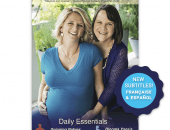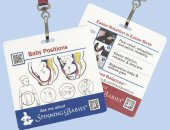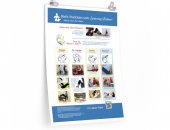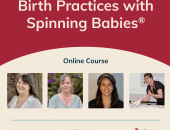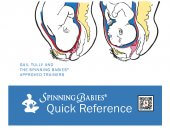Physicians
Physicians can monitor fetal position with an ultrasound. When a baby is discovered to be breech or transverse, the doctor may offer a “version,” or manually flip the baby by turning the baby with their hands. Posterior babies are not manipulated in this manner because it is not likely to succeed. It doesn’t seem that it would be easy on the posterior baby either.
An attempt to externally turn the baby, External Cephalic Version (ECV), is safer to do after the baby’s lungs are matured. The concern with doing one earlier is that the force of manipulating the baby can (though rarely) pull the placenta from its warm nest in the uterine lining. An emergency cesarean would be done to try and save the baby in this case.
To help with the success of the ECV, a doctor keeps close watch on the baby with an ultrasound and may want to use Tributaline, a drug used to relax the uterine wall. This drug can make moms edgy and jittery for a short time. The idea, though, is to make the uterine wall less resistant to turning the baby. It is also a drug used to stop premature labor contractions.
To prepare for an ECV, I suggest doing a week of daily Fantastic Four body balancing techniques and pelvic alignment activities with self-care and a professional before the External Cephalic Version, when time allows.
Midwives
Midwives must have a chance to develop their skills to feel a baby’s position with their hands. This takes both time and experience. In clinical settings where appointments are short, midwives may not have the time (or the training) to tell a breech from a head-down baby in a mother who has a tight broad ligament or firm abs. But with enough experience, midwives can pick up the subtle details of fetal positioning.
Midwives are more likely than physicians to have palpation skills because with a faster-paced clinic day, providers have less time for actually feeling the baby. Nevertheless, sometimes it’s hard to tell exactly how a baby is lying in the womb.
Even when a midwife knows that the baby is in a posterior, breech, or transverse position, their opinion of when to do something about it can vary. Some midwives feel that we should just trust nature and wait and see what happens. This attitude will result in about a 3-4% breech occurrence at the time of birth, and an even higher rate of posterior presentation.
Some midwives will work with the mothers to use good maternal positioning in pregnancy. They will refer pregnant people to alternative practitioners who can help achieve a better fetal position if the baby doesn’t seem to be able to do so by 34-36 weeks. A few midwives also work with mothers to help the baby get head down by 30-32 weeks.
Midwife Anne Frye is the author of Holistic Midwifery as well as many other midwifery textbooks. She promotes the use of a gentle method of version at 30 weeks gestation.
A word on manual versions
The doctor or midwife tries to move the breech or transverse baby head down by pushing through the mother’s abdomen against the baby’s body. Version carries a risk and so should never be done by an inexperienced person, no matter their title (sometimes a student, new caregiver, or bold bodyworker might be tempted to overstep their experience to try to do what they assume is a good deed).
Monitoring the heartbeat is so important because a slowing heartbeat will be the first sign that the baby shouldn’t go further in that direction. Manual external version has risk of tearing the placenta from the womb, tightening a wrapped cord, and turning the head and body without bringing the arm along, so that the arm is left in an awkward angle. Most often the version goes fine, but it has risks with letting the baby stay breech and either having a vaginal birth or a cesarean (though hopefully not until labor begins on its own).
Penny Simkin recommends a doula or other supportive person be with the mother through the version. The trained doula often has experience with eye-to-eye contact and a type of verbal coaching that is very helpful through potentially difficult procedures such as this.
A 2003 study, “External cephalic version beginning at 34 weeks’ gestation versus 37 weeks’ gestation: A randomized multicenter trial,” shows higher rates of vaginal birth for people who had external cephalic version at 34 weeks rather than at 37 weeks, which is currently the accepted time in pregnancy to do so.
Physical therapists
Physical therapy can help mothers cope with many pregnancy discomforts. Some pregnant people find that a physical therapist may be covered on their insurance, whereas a chiropractor may not be. There are lots of different kinds of physical therapists, so it’s important to understand the differences between them.
Prenatal massage therapists
Prenatal massage can be relaxing and beneficial for hormonal function and the relief of pregnancy discomforts. As a result, it can also help one to get better sleep. That being said, “prenatal massage” is not specific for improving fetal position whatsoever.
Therapeutic massage in pregnancy and labor
Here is a massage that does get into making room for the baby, although the therapists and their offerings can vary. Seek the “go-to” person for pregnancy and birth in your area.
Chiropractors
Chiropractic spinal and pelvic adjustments can reduce or resolve pregnancy discomforts such as back pain, hip pain, sciatica, and heartburn. Chiropractors help with optimal fetal positioning by helping the pelvis to be symmetrical. This in turn helps the uterus to be more symmetrical.
Adjustments can help the baby to fit the brim better to engage in time and help stimulate cervical ripening. Adjustments also make the pelvis more flexible so that pelvic joints move more easily in labor.
Ask your chiropractor about adjustments of:
- The sacrum, both vertically (SI joints) and horizontally (for a buckled sacrum)
- The symphysis pubis (pevlis)
- The neck
Neck adjustments do improve pelvic alignment, especially if accompanied by myofascial release. Not all chiropractors are trained in myofascial release though.
Dr. Carol Phillips, DC, recommends addressing the skeletal system through adjustments, but equally addressing the fascia (with myofascial release) and the cranial rhythm (with gentle craniosacral therapy). She teaches everyone who works with pregnant and birthing people techniques that have been effective in her experience (and now in mine).
If you’d like to learn more about chiropractic care, you can watch Dr. Jeanne Ohm speaking about natural birth and fetal rotation. You can also watch two videos on chiropractic care in pregnancy to help a breech baby spontaneously flip head down.
Craniosacral therapy
Craniosacral therapy is gentle and can be a dramatically effective technique that helps pregnant people as well as newborns. Newborn techniques are a little different than adult techniques (such as how the temporal bone is worked with) so special training is highly recommended.
Dynamic body balancing
Check out the Dynamic Body Balancing techniques of chiropractor Carol Phillips, DC. She takes chiropractic knowledge, myofascial release, and craniosacral therapy with an energy approach.
Dr. Phillips’ Dynamic Body Balancing workshops give the necessary information for broad application by any bodyworker. Beginners are welcome, and chiropractors who attend will get additional instructions for when to apply particular adjustments. This series can be taken by anyone dedicated to serving pregnant people in this way.
[Insert video: https://www.youtube.com/watch?time_continue=1&v=9FD984sNbHU&feature=emb_logo]
This is a fascinating video to learn about her work with pregnancy. Listen to her talk about her daughter Angel’s difficult infancy and childhood symptoms. Today, Angel is one of the Twin Cities’ favorite craniosacral and Dynamic Body Balancing practitioners!
Acupuncture
Acupuncture uses extremely thin needles. Sometimes you feel them and many times you don’t. Acupuncture is well studied and quite effective for helping a breech to flip. Acupuncture has been shown to be more effective for flipping a breech compared to waiting to see if a baby will turn head down on their own.
Traditional Chinese acupuncture is also used for all pregnant people in the 6th and 7th month for the “Bright Baby” treatment. Needles may be placed in the ears, hands, feet, or limbs. There are inexpensive community acupuncture clinics in many cities.
Moxibustion
Moxibustion uses a tightly rolled stick of mugwort herb, much like a stick of incense. The coal at the end of the moxibustion stick is held over an acupuncture point to heat it up. Repeated 2-3 times a day for 2.5 minutes per side of the body has given success to some mothers in flipping breech babies. The highest rates of success often came in the 34-35th weeks of pregnancy.
Maya massage
Unlike pregnancy massage, Maya massage is not for relaxation specifically, but rather for treatment. Regular sessions are a big part of Yucatan midwifery. It is tricky to find a practitioner outside of the Mexican Yucatan, however. This is highly recommended for fetal positioning if you can find a practitioner. It’s also great for menstrual and perimenopausal symptoms, and for retroverted uteri.
Myofascial release
Myo means muscle and fascia is the leathery coating covering the muscles and bones of our body. This technique helps relax parts of our body that we cannot relax with deep breathing or rest alone. The uterine ligaments have an amount of muscle tissue in them, and this allows the ligaments to grow with the uterus.
Craniosacral therapy utilizes myofascial release and some chiropractors know this technique as well. A chiropractor can adjust our joints, but if the fascia is constricted or bunched up, it will pull the bones back out of place. Pregnancy hormones tend to allow more movement though, meaning adjustments made won’t last as long.
Alexander Technique
All of us can move with more balance and relaxation. The British Medical Journal did a study on the Alexander Technique. It does not discuss pregnancy, but does show how the Alexander Technique has been proven to reduce chronic back pain in six lessons without the use of drugs or contraptions. Consult an instructor on how to use this in pregnancy.
Alternative medicine
Herbs
Herbs can be for seasoning, nutrition, or for healing. Nutritive herbs are like a special food for a specific purpose. Red Raspberry Leaf, for instance, helps tone the pelvic floor and uterus. It is high in calcium and reduces leg cramps and nausea while being safely (and widely) used in pregnancy. Just make sure the Red Raspberry Leaf tea you buy is not simply flavored black tea.
A few drops of Mitchella can be used nightly in late pregnancy if uterine contractions seem to keep you awake without bringing labor on. A dropper full of Motherwort tincture can calm the mind to help a tired woman fall asleep, but should not be used longer than three consecutive weeks.
I rarely recommend Blue Cohosh to start labor, for instance, because I’ve noticed that it is hard for mothers to dose themselves effectively by following the recipe. In my opinion, there are other ways that are more manageable and successful without requiring the necessary experience to get a labor going without causing contractions that can last too long or give the mother huge contractions after the birth.
Homeopathy
There are a handful of homeopathic remedies that actually help babies get into improved fetal positions. Pulsatilla (wind flower) is known to help a breech flip head down, and I find it helps many posterior babies too. Side effects can occur though, so please consult a trained homeopath first.
Over-the-counter doses should only be taken for three days at a time before stopping the remedy. A typical suggestion is to take five pellets under the tongue, once at night for three nights. Take a homeopathic remedy when the mouth is clean of food or toothpaste flavors, and without touching the tablets, which are too sensitive to withstand skin oils.
Some suggest you stop taking Pulsatilla for three days and then take it once a night again for three days. Then stop for a couple weeks, but continue trying maternal positions and getting body work. If the baby is moving more freely after taking a dose, you know it’s working. If the baby doesn’t flip after moving more freely, a more “deep” dose is indicated, but consultation here is highly recommended. If no reaction occurs, consult a homeopath.
If you have only days to flip a baby, or are in labor with a posterior baby who is having trouble rotating, you may need a “deeper dose.” You need a professional homeopath to make sure you get the right dose.
Pulsatilla is also associated with mucous production, including in the lungs. When a deeper dose is taken, there can be some associated congestion. One mom with a history of chronic asthma had an asthma attack while her baby flipped head down. Other moms have had no congestion. Consult a professional homeopath, please.
Osteopathy
Brian, an osteopath in Southern California, wrote:
A D.O. who practices manipulation would fill many of your categories: doctor, chiropractor, craniosacral therapist, and myofascial release practitioner. I would encourage you to visit the AAO and Cranial Academy pages for further information.
From Caroline Stone, author of Visceral and Obstetric Osteopathy:
The osteopathic interpretation of optimal fetal positioning would concur with [Jean Sutton], but would also consider that biomechanical factors in and around the mother’s spine, pelvis, and hips, tighter with mechanical tensions acting on and around the uterus, would also influence the position of the fetus in late pregnancy and leading up to birth. Releasing tensions in the pelvis, hips, back and tissues surrounding the uterus is thought to relieve physical stress around the uterus, making its mechanical environment as accommodating as possible, thereby allowing the fetus to align itself in the most optimal position… It should be stressed that the osteopathic approach is not to perform “external cephalic version.”
Copyright Elsevier (2006). Permission was given to include this quote on the Spinning Babies® Website.
Closing thoughts
You can see that the listing here allows pregnant people and their babies to move into position to help themselves in a gentle, non-invasive manner. I’m not always against interventions, and sometimes invasive interventions become necessary. But when we help ourselves become symmetrical and relax involuntary muscles, then the baby and body can do what they are well designed to do—and often the intervention is no longer needed.
Once again, if you are looking for a Spinning Babies® Aware Practitioner, you can find one here on our practitioner directory.

